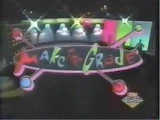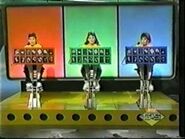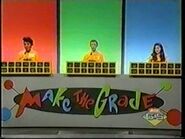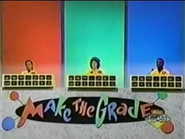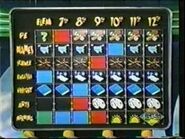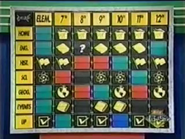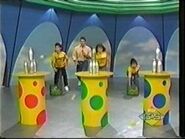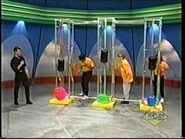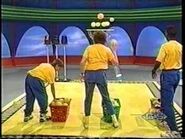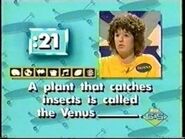| Hosts | |
| Lew Schneider (1989-1990) Robb Edward Morris (1990) | |
| Announcer | |
| Maria Milito | |
| Broadcast | |
| Nickelodeon: 10/2/1989 – 9/14/1990 (Reruns until 12/29/1991) | |
| Packagers | |
| Nickelodeon/MTV Networks | |
Make the Grade was a short-lived educational game show where kids would get a chance to test their knowledge.
Gameplay[]
Main Game[]
Three contestants who sat in colored desks (red, green, and blue) competed to answer questions and capture squares on a giant game board, which was a 7x7 grid. The game was played on that board in which the squares were split flaps or solaris; above the board were seven grade levels and on the left side were seven subjects; the 49 squares consisted of icons representing those subjects.
In the first season, each episode had a different set of all seven categories. In the second and third seasons, the last category was a "Special Elective", which was represented by a checkmark.
The player in control picked a square by grade level and subject; when a question mark (?) was exposed, the host read a question to all three players. The first player to buzz-in with a correct answer won the question, capturing the square that then appeared in the same color as that player's desk and control of the board. If incorrect, the other two had a chance to answer once the host had re-read the question. If no one answered correctly, the square turned black and could not be selected again, which Schneider referred to as a "dead square".
In addition to capturing squares, correct answers would also light up icons (subjects and grades) on their own scoreboard on their desk. There were 14 icons with the same education levels and subjects as on the board, so the purpose of the game was to answer at least one question for every subject and education level.
Subjects[]
The school subjects were:
- History
- Music
- Science
- Home Economics
- Geography
- P.E.
- Mathematics
- English
- Arts
- Social Studies
- Current Events
Wild Cards[]
While there were question spaces up on the board, it had other spaces as well which could really effect the game.
- TAKE – Allows a player to steal any square from an opponent.
- LOSE – Forces a player to give up a square of his/her choice, which would be placed back on the board as another question or wild card.
- FREE – Gives the square to the contestant who picked it without having to answer a question.
- FIRE – Where all contestants competed.
Fire Drills[]
Like other Nickelodeon game shows, Make the Grade allowed contestants to participate in (sometimes messy) challenge stunts called "Fire Drills." Fire Drills took place when a contestant selected a square with the Fire wild card, forcing all three contestants participate.
The goal of each Fire Drill was to complete the challenge first, thereby earning first choice at the three desks. When contestants answered questions correctly, the squares they earned belonged to the desks at which they were seated, rather than the contestants themselves. Once the Fire Drill was completed, the first place contestant picked whichever desk he or she desired, usually the one with the most grade levels and subjects completed. The second place contestant got his/her choice of the remaining two desks, and third place took the last desk remaining.
Because of this structure, a contestant could do poorly in answering questions but successfully complete Fire Drills to win the game. In extreme situations, a contestant completed their cards and won the game with one correct answer. While it was theoretically possible to win a game without answering any questions (by winning a fire drill, being only one square away from victory, and picking a "free" or "take" square), this never happened.
To see a list of all Fire Drill events, click on the link near the bottom.
The first player to light up all of the icons, or to have the most when time ran out in Round 2 would be the winner.
The way they could win was to capture squares on the board in any pattern; one could go diagonally one way or the other, make a random path, or complete one complete row and one complete column. However, since most of the time there was competition, the typical way to win was to try to answer as many questions as possible.
If there was a tie between two or more contestants in icons at the end of the second round, the player with the most captured squares won the game, and if there was a tie for that too, one final sudden-death tiebreaker question was asked from one of the subjects. The first contestant to buzz in with the correct answer advanced to the Honors Round.
The winner of the main game won $500 and got to move on to the "Honors Round" for more cash and (later in the run) a grand prize. Losing players only won $50 and two or three parting gifts. Win or lose, all contestants were given British Knights sneakers to take home.
Honors Round (Bonus Round)[]
In the "Honors Round", the winning contestant had to answer seven questions in 45 seconds or less. To start, the winning contestant received a choice of three categories. Each category was divided into seven school subjects; the player's job was to answer questions (one from each of the seven subjects under the chosen category) and get them all correct before the 45 seconds ran out.
First Season[]
Each subject only had one question and the winning contestant only got one chance to answer the question correctly, although he/she could pass and come back to it later.
Last Two Seasons[]
Each subject now had two questions and if the winning contestant missed the first question or passed on it, they would get a new question in the same subject should they come back to it later.
In either case, the first six correct answers were worth $100 each. A big prize was won if the round was completed successfully. For the first season, the prize was $1,000, and for seasons two and three it was was changed to $600 and a trip back to Universal Studios in Florida where the show was taped.
Extra Time at the End of the Show[]
Whenever there was extra time at the end of the show, there would be an activity going to fill the remaining time.
Schneider's Extra Time[]
For the first season of Schneider's tenure, he would go out into the public (mostly into malls) and ask general people a series of questions.
University Round[]
For the second season during the Lew Schneider run, the winning contestant would play a special round called the "University Round" where that player would be asked a series of questions unplayed from previous games. The first question was worth $50, the second was worth $100, there was $200 for the third, $500 was rewarded for the fourth, and the final question would be worth $1,000. If the winning contestant missed a question at any point, he/she lost the money from that round, and not the money nor prize from the main game or "Honors Round", which was why the contestant had the option to stop after each correct answer.
Morris' Extra Time[]
During Morris' tenure as host in the third and final season, whenever there was some time to fill after the "Honors Round", Morris' would go out into the audience and ask them a series of questions (again from past games though not always unused). Correct answers from them won a small prize, like a t-shirt or other goodies.
However, there came times when a contestant finished his/her scoreboard so early that a new group of contestants had to play in the second round.
Broadcast history[]
NOTE: All times are Eastern.
| Date | Time slot |
|---|---|
| Fall 1989 - Spring 1991 | Weekdays, 6:30 p.m. |
| Summer - Fall 1991 | Weekends, 4:30 p.m. |
| Fall - Winter 1991 | Sundays, 4:30 p.m. |
Music[]
Inventor[]
Robert Mittenthal
Additional Pages[]
Make the Grade/Quotes & Catchphrases
Make the Grade/List of Fire Drill Events
Links[]
Jay Anton's Rules for Make the Grade
Make the Grade Rules @ Loogslair.net
Another Make the Grade Rules Page

